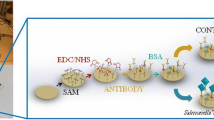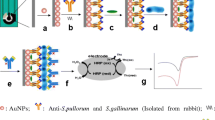Abstract
In this article, an original method is proposed for address and covalent immobilization of anti-E. coli antibodies on a screen-printed electrode (SPE). The method is based on a copper-catalyzed “click” reaction between a polyvinylbenzylazide (PVBA) film electrochemically deposited on the electrode surface and acetylene fragments of propargyl-N-hydroxysuccinimide ester. The products of electrochemical oxidation of copper particles incorporated in the polymer film on the electrode were first used for catalysis of the click reaction. This approach allowed us to reduce the immobilization time from a few hours for conventional methods to just 30 min, and to prevent denaturation of the immunoreceptor. The modified electrodes were characterized by scanning electron microscopy (SEM), electrochemical impedance spectroscopy (EIS), and cyclic voltammetry (CV). Based on the results obtained, a label-free impedimetric immunosensor for E. coli detection was developed. The detection limit of the immunosensor was estimated as 6.3 CFU/ml, with a linear range of 103–106 CFU/ml. The immunosensor demonstrated good stability during 30 days of storage in phosphate buffer solution (PBS, pH 7) and selectivity toward excess Staphylococcus aureus bacteria.













Similar content being viewed by others
References
Felix FS, Angnes L. Electrochemical immunosensors—a powerful tool for analytical applications. Biosens Bioelectron. 2018. https://doi.org/10.1016/j.bios.2017.11.029.
Evtugyn G. Biosensors: essentials. Springer; 2014.
Rostovtsev VV, Green LG, Fokin VV, Sharples KB. A stepwise Huisgen cycloaddition process: copper-catalyzed regioselective “ligation” of azides and terminal alkynes. Angew. Chem Int Ed. 2002. https://doi.org/10.1002/1521-3773(20020715)41:14<2596::AID-ANIE2596>3.0.CO;2-4.
Tornøe CW, Christensen C, Meldal M. Peptidotriazoles on solid phase: [1,2,3]-triazoles by regiospesific copper(I)-catalyzed 1,3-dipolar cycloadditions of terminal alkynes to azides. J Org Chem. 2002. https://doi.org/10.1021/jo011148j.
Lesniewski A, Matyjewicz J, Palys B, Niedziolka-Jonsson J. Electroassisted click chemistry immobilisation of gold nanoparticles on a solid substrate. Electrochem Commun. 2015. https://doi.org/10.1016/j.elecom.2015.01.019.
Sarkar A, Mukherjee T, Kapoor S. PVP-stabilized copper nanoparticles: a reusable catalyst for "click" reaction between terminal alkynes and azides in nonaqueous solvents. J Phys Chem. 2008. https://doi.org/10.1021/jp077603i.
Girard C, Önen E, Aufort M, Beauvière S, Samson E, Herscovici J. Reusable polymer-supported catalyst for the [3+2] Huisgen cycloaddition in automation protocols. Org Lett. 2006. https://doi.org/10.1021/ol060283l.
Chtchigrovsky M, Primo A, Gonzalez P, Molvinger K, Robitzer M, Quignard F, et al. Functionalized chitosan as a green, recyclable, biopolymer-supported catalyst for the [3+2] huisgen cycloaddition. Angew Chem Int Ed. 2009. https://doi.org/10.1002/ange.200901309.
Lin PC, Ueng SH, Tseng MC, Ko JL, Huang KT, Yu SC, et al. Site-specific protein modification through Cu(I)-catalyzed 1,2,3-triazole formation and its implementation in protein microarray fabrication. Angew Chem Int Ed. 2006. https://doi.org/10.1002/anie.200600756.
Sánchez-Tirado E, González-Cortés A, Yáñez-Sedeño P, JPingarrón JM. Carbon nanotubes functionalized by click chemistry as scaffolds for the preparation of electrochemical immunosensors. Application to the determination of TGF-beta 1 cytokine. Analyst. 2016. https://doi.org/10.1039/C6AN00941G.
Rydzek G, Terentyeva TG, Pakdel A, Golberg AD, Hill JP, Ariga K. Simultaneous electropolymerization and electro-click functionalization for highly versatile surface platforms. Am Chem Soc. 2014. https://doi.org/10.1021/nn501306y.
Veera Narayana Reddy M, Chandra Sekhar Reddy G, Suresh Kumar K, Suresh Reddy C, Naga Raju C. Synthesis, antioxidant and antimicrobial activity of novel benzene-1,4-diamine-bis-dioxaphosphepine-6λ5 iminophosphoranes. J Hetero Chem. 2010;47:538–542.
Lebrun C, Deniau G, Viel P, Lécayon G. Electrosynthesis of poly(4-vinylpyridine) films on metallic surfaces under anodic and cathodic polarizations: structure and properties of the organic coatings. Surf Coat Technol. 1998. https://doi.org/10.1016/S0257-8972(97)00674-9.
Viel P, Palacin S, Descours F, Bureau C, Le Derf F, Lyskawa J, et al. Electropolymerized poly-4-vinylpyridine for removal of copper from wastewater. Appl Surf Sci. 2003. https://doi.org/10.1016/S0169-4332(03)00105-3.
Zhao H, Chang J, Boika A, Bard AJ. Electrochemistry of high concentration copper chloride complexes. Anal Chem. 2013. https://doi.org/10.1021/ac4016769.
Guner A, Cevik E, Senel M, Alpsoy L. An electrochemical immunosensor for sensitive detection of Escherichia coli O157:H7 by using chitosan, MWCNT, polypyrrole with gold nanoparticles hybrid sensing platform. Food Chem. 2017. https://doi.org/10.1016/j.foodchem.2017.02.083.
Li Y, Xiong Y, Fang L, Jiang L, Huang H, Deng J, et al. An electrochemical strategy using multifunctional nanoconjugates for efficient simultaneous detection of Escherichia coli O157: H7 and Vibrio cholerae O1. Theranostics. 2017; https://doi.org/10.7150/thno.17544.
Zhu F, Zhao G. Electrochemical sandwich immunoassay for Escherichia coli O157:H7 based on the use of magnetic nanoparticles and graphene functionalized with electrocatalytically active Au@Pt core/shell nanoparticles. Microchim Acta. 2018. https://doi.org/10.1007/s00604-018-2984-2.
Tardittoa LV, Zona MA, Ovandob HG, Vettorazzia NR, Arévaloa FJ, Fernándeza H. Electrochemical magneto immunosensor based on endogenous β-galactosidase enzyme to determine enterotoxicogenic Escherichia coli F4 (K88) in swine feces using square wave voltammetry. Talanta. 2017. https://doi.org/10.1016/j.talanta.2017.06.059.
Zhou Y, Marar A, Kner P, Ramasamy RP. Charge-directed immobilization of bacteriophage on nanostructured electrode for whole-cell electrochemical biosensors. Anal Chem. 2017. https://doi.org/10.1021/acs.analchem.6b03751.
De Miranda JL, Oliveira MDL, Oliveira IS, Frias IAM, Franco OL, Andrade CAS. A simple nanostructured biosensor based on clavanin A antimicrobial peptide for gram-negative bacteria detection. Biochem Eng J 2017; https://doi.org/10.1016/j.bej.2017.04.013.
Mintz-Hemed N, Yoetz-Kopelman T, Convertino A, Freeman A, Shacham-Diamand Y. Whole-cell electrochemical biosensor integrating microbes with Si nanowire-forest. J Electrochem Soc. 2017. https://doi.org/10.1149/2.1471706jes.
Acknowledgements
The research was supported by the Russian Science Foundation (grant number 18-73-00224).
Author information
Authors and Affiliations
Corresponding author
Ethics declarations
Conflict of interest
The authors declare that they have no conflict of interest.
Research involving human participants and/or animals
This article does not contain any studies with human participants or animals performed by any of the authors.
Additional information
Publisher’s note
Springer Nature remains neutral with regard to jurisdictional claims in published maps and institutional affiliations.
Published in the topical collection Euroanalysis XX with guest editor Sibel A. Ozkan.
Electronic supplementary material
ESM 1
(PDF 247 kb)
Rights and permissions
About this article
Cite this article
Svalova, T.S., Medvedeva, M.V., Saigushkina, A.A. et al. A label-free impedimetric immunosensor based on covalent immobilization of anti-E. Coli antibody via a copper-catalyzed azide-alkyne cycloaddition reaction. Anal Bioanal Chem 412, 5077–5087 (2020). https://doi.org/10.1007/s00216-019-02381-1
Received:
Revised:
Accepted:
Published:
Issue Date:
DOI: https://doi.org/10.1007/s00216-019-02381-1




